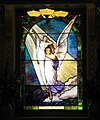San Francisco Columbarium & Funeral Home
This article needs additional citations for verification. (July 2010) |
 | |
| Details | |
|---|---|
| Established | 1898 |
| Location | |
| Country | United States |
| Coordinates | 37°46′50″N 122°27′25″W / 37.78056°N 122.45694°WCoordinates: 37°46′50″N 122°27′25″W / 37.78056°N 122.45694°W |
| Owned by | Dignity Memorial |
| No. of graves | ~8,500 niches |
| Website | www |
| Find a Grave | San Francisco Columbarium |
| Designated | 1996[1] |
| Reference no. | 209 |
The San Francisco Columbarium & Funeral Home is a columbarium (repository for human ashes) owned and operated by Dignity Memorial, at One Loraine Court, near Stanyan and Anza Streets, just north of Golden Gate Park in San Francisco, California. Built in 1898 by architect Bernard J.S. Cahill, the copper-domed Columbarium is an example of Neo-Classical architecture. It is the only non-denominational burial place within San Francisco's city limits that is open to the public and has space available.
History[]
The Columbarium was once part of the , which encompassed approximately 30 acres (12 ha). It was built to complement an existing crematorium designed by Cahill in 1895.
In 1902 the San Francisco Board of Supervisors passed an ordinance to prohibit the sale of cemetery lots or permit any further burials within the city. By late 1910, cremation was also prohibited. The Odd Fellows, forced to abandon their cemetery, established Green Lawn Cemetery in Colma. Transfer of bodies began in 1929 and many families also chose to remove their urns from the Columbarium. The crematorium and various mausoleums were demolished, and many of the headstones were used to build a seawall at Aquatic Park. The Columbarium remained, as well as interments below ground that were missed during exhumation, such as the mummified body of Edith Howard Cook.
After a time, the Columbarium was sold to the Bay Cities Cemetery Association and later to Cypress Abbey. As it passed from one organization to another it fell into disrepair. In 1980, the Neptune Society of Northern California bought it and began restoration. Among others, Emmitt Watson was hired by the Neptune Society as a painter but became the primary restorer of the building and functions as de facto tour guide to this day.[2][3]
In 1996, the building was added to the register of San Francisco Designated Landmarks.[1]
Design[]
The Columbarium combines baroque and neoclassical features. Cahill was probably inspired by the Columbian Exposition of 1893 in Chicago. The diameter, from the entrance to the stained glass window opposite, is 64 feet (20 m). The width of the rotunda within the Inner circle is 29 feet (8.8 m) and the rotunda reaches a height of about 45 feet (14 m).
The eight rooms on the ground floor bear the names of the mythological winds. Six of the ground floor rooms feature beautiful stained glass windows. The window in the Aquilo room depicting three angels in flight, is attributed equally to Louis Comfort Tiffany or John LaFarge. The first floor rooms are named after constellations. The second and third floors are simpler in design.
The first floor contains approximately 2,400 niches, the second floor 2,500, and the third and fourth floors approximately 1,800 each, with an overall total of more than 8,500.
Notable interments[]
The Columbarium holds the remains, memorials, and cenotaphs of some of San Francisco's most prominent founding families, and celebrities:[4][5]
- George Ainslie (1838–1913) – Congressional delegate from Idaho Territory
- John Backus (1928–2007) – Pioneering computer scientist, creator of Fortran and 1977 Turing Award recipient
- Chet Helms (1942–2005) – Music promoter and father of San Francisco's 1967 "Summer of Love"
- Frank E. Hill (1850–1906) – US Army officer during the American Indian Wars and Medal of Honor recipient
- Thomas N. Howard (1957-2017) – Music and concert promoter-extraordinaire for Bill Graham Presents and The Howard Company
- Harry August Jansen (1883–1955) – Professional magician, also known as Dante the Magician
- Jerry Juhl (1938–2005) – Muppeteer and writer for the Muppets
- Anna Elizabeth Klumpke (1856–1942) – Genre painter and companion to the great French animal painter Rosa Bonheur
- Dorothea Klumpke (1861–1942) – Astronomer and mathematician; 339 Dorothea and 1040 Klumpkea were named after her
- Domingo Marcucci (1827–1905) – Venezuelan born 49er, shipbuilder and shipowner in San Francisco
- Harvey Milk (1930–1978) – American politician; first openly gay man elected to a public office in California
- Jose Santana (1918–1997) – Mexican born violinist who performed with symphony orchestras and mariachi bands. He was the father of rock guitarist Carlos Santana
- Edward Robeson Taylor (1838–1923) – 28th Mayor of San Francisco
Gallery[]

View of the Columbarium's interior

Room with urns on the second floor

A stained glass window in the Columbarium

The stained glass window in the dome ceiling
See also[]
References[]
- ^ a b "City of San Francisco Designated Landmarks". City of San Francisco. Retrieved 2012-10-21.
- ^ "S.F. Columbarium in good hands with Emmitt Watson". San Francisco Chronicle. Retrieved 2019-09-19.
- ^ "What is a columbarium? An Interview with Emmitt Watson". Seven Ponds. Retrieved 2019-09-19.
- ^ Charlie Wells (July 25, 2010). "Bay Area famous graves". The San Francisco Chronicle. Retrieved 28 July 2010.
- ^ "San Francisco Columbarium". Find A Grave. 2010. Retrieved 28 July 2010.
External links[]
| Wikimedia Commons has media related to San Francisco Columbarium. |
- Cemeteries in San Francisco
- Columbaria
- Buildings and structures in San Francisco
- Buildings and structures completed in 1898
- San Francisco Designated Landmarks
- Tourist attractions in San Francisco
- 1890s architecture in the United States
- Beaux-Arts architecture in California




